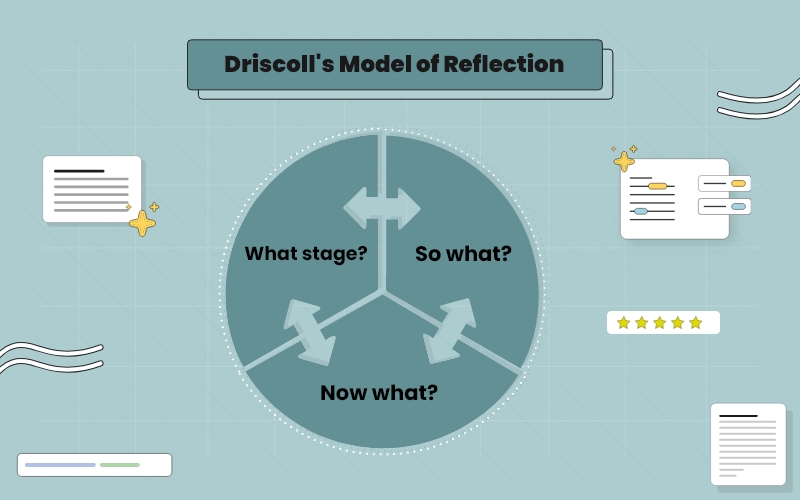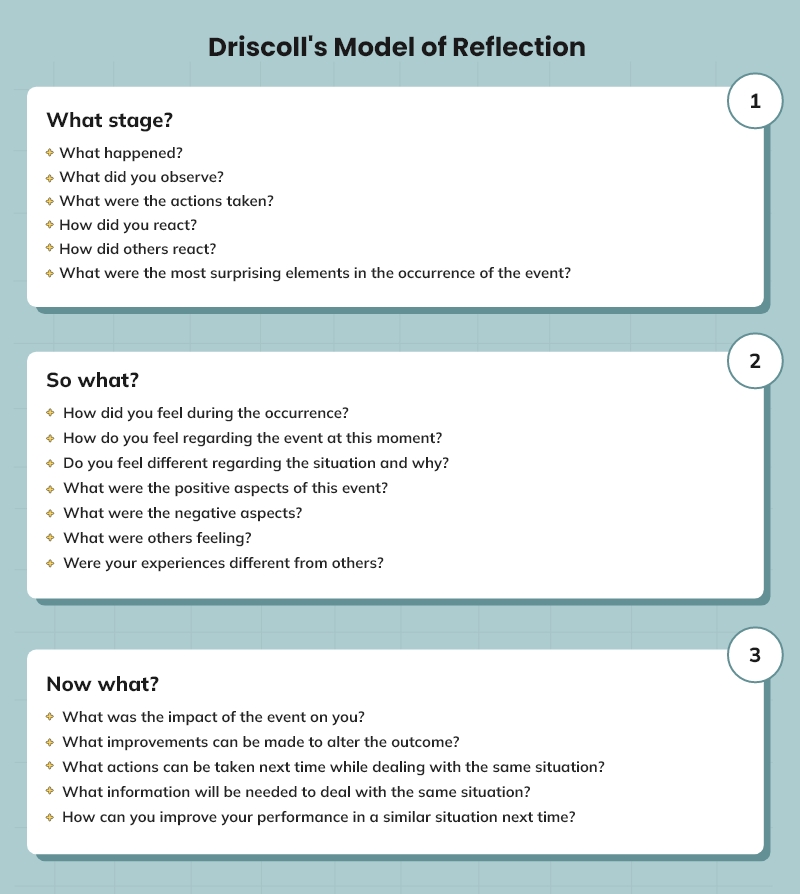
Overview
Driscoll gave the model of reflection in 1994 as a framework to guide self-reflection among individuals regarding some event or happenings. The model was developed on a basis of the Borton model of reflection which focuses on three questions (Gladd, 2021). What? So what? and Now what? These three questions help to reflect on an event or situation but do you know that answering these questions can be ambiguous at times? Yes, this is a reason that Driscoll developed a new reflective model by matching it to the experiential learning cycle. Driscoll's model of reflection also provided additional guidance regarding what should be reported at each stage of reflection.
Table of Contents
Three stages of Driscoll’s model of reflection
Stage 1: What stage
The first stage in this reflection is “What stage?” which considers describing a whole situation by answering a few questions which are listed as follows-
- What happened?
In this stage, you will focus on the background information highlighting instances of the event you are reflecting upon. - What did you observe?
In this, you will focus on the additional information that you noticed throughout the occurrence of the event. - What were the actions taken?
In this, you will highlight the major actions taken by you and the other people involved in the situation. - How did you react?
While answering this question, you will focus on the reactions given by you throughout the event occurrence. - How did others react?
In this, you will highlight the various ways in which others involved in the situation reacted. - What were the most surprising elements in the occurrence of the event?
In this, you will highlight the aspects of the event that gave you a feeling of shock or surprise.
Stage 2: So what
The second stage of this reflection is “So what?” which aims to promote understanding of the event by triggering reflection on the feelings of individuals regarding the event. The few questions that are answered at this stage include-
- How did you feel during the occurrence?
In this, you will focus on underlining the feelings you had during the event you are reflecting upon. - How do you feel regarding the event at this moment?
While answering this question, you will highlight the feelings you are having about the event at this moment. - Do you feel different regarding the situation and why?
In this, you will highlight the difference in feelings during and after the occurrence of the event. - What were the positive aspects of this event?
In this, you will focus on all the positive things that happened during the event. - What were the negative aspects?
After highlighting the positive aspects, you will also focus on the negative aspects of the event. - What were others feeling?
While answering this question, you will highlight the feelings of other people involved in the situation. - Were your experiences different from others?
In this, you will highlight the fact whether your experience was different from others or not.

Stage 3: Now what
The third stage of this reflection is “Now what?” where an action plan for dealing with the same situations in the future is developed. This stage includes the impact of an event on individuals and self-awareness about how and why individuals acted in a certain way. The few questions which can be answered at this stage include-
- What was the impact of the event on you?
In this, before creating an action plan, you have to focus on the impact of the event on you. - What improvements can be made to alter the outcome?
While answering this, you will highlight the ways in which you can improve and make the outcome better for future situations. - What actions can be taken next time while dealing with the same situation?
In this, you will list out one or two actions that you will take if the future situations occur again. - What information will be needed to deal with the same situation?
In this, you will answer what information which can be theoretical or practical is needed in order to react or attain the SMART nursing goals for similar situations in the future. - How can you improve your performance in a similar situation next time?
Lastly, you will highlight the ways in which you will improve your performance for a similar situation in the future.
Since Driscoll's model of reflection helps to properly investigate the situation, this model is mainly used in a health care setting by nurses to provide a reflection on their experience or medical situation and to identify actions that can be taken for self-improvement and to improve the quality of care in the future. So, let us take an example of a nursing situation to apply Driscoll's model of reflection.
Driscoll’s model of reflection example
Case assessment - This reflective example will highlight the experience of a nurse working in a surgical ward conducting surgery to remove the appendix. This reflective example will focus on the nurse's experience and challenges she faced while engaging in appendectomy.
Whilst being in a surgical ward, I was required to engage in an appendectomy which is emergency surgery to remove the appendix.During this situation, I found that I cannot perform laparoscopic surgery due to the severity of appendicitis in a patient. Thus, I informed the patient that an open appendectomy will be performed and got informed consent. Thus, I made one incision on the lower right side of the abdomen of a patient and then removed the appendix. However, after surgery, it was noticed that a patient developed hepatitis B. My senior doctor then contacted me and informed me that there are very few causes of Hepatitis B, which include sharing of needles, at the time of birth and sexual contact. Besides, the main cause for the occurrence of Hepatitis B, in this case, is the use of some infected tool or equipment during surgery. There is a major possibility that these occult infections are often caused by HBV mutants that have been proposed (Liang, 2009). I was very shocked after hearing this and then recalled a whole situation where I identified that I didn’t follow all steps needed to prevent the spread of blood-borne infections. A senior doctor then guided me about procedures for preventing healthcare-associated infections and also asked me to study patient safety guidelines.
At the beginning of the appendectomy of a patient, I was bit confused about the procedure of giving anesthesia. However, I was able to successfully give all injections and medicines which helped me to develop confidence and perform this surgery but when I found that a patient developed hepatitis B due to some little mistake in surgery, I felt very guilty and sad. I also feel very sad when I recall the same situation. I believe that I was required to treat a patient for an appendix but ended up developing some other health problems.After facing this situation, my senior doctor also felt very ashamed as he was not able to completely guide me and prevent such issues.The most negative aspect of the situation was that I disappointed my seniors and was not able to perform well.However, one thing that I felt was good about the situation was that I got to learn something new that will definitely help me in the future.However, one thing that I felt was good about the situation was that I got to learn something new that will definitely help me in the future.Now, I have learned that healthcare-associated infections are one serious problem that can be prevented by following various healthcare safety practices and principles. I also found that evidence-based care practices can be followed to prevent various mistakes in health care.
The occurrence of this event had a major impact on me that I was not able to perform well. However, it also made me more determined to learn more and more about nursing practice and become a better version of myself. After facing this situation, I found that I need to be more prepared to engage in various healthcare situations to prevent various healthcare risks.I believe that I can follow various nursing codes such as the NMC code of nursing which includes four principles i.e. prioritizing people’s safety, practicing effectively, preserving patient safety, and promoting professionalism and trust to promote quality of healthcare.Along with this, I found that I also need to learn about various infection control practices before undertaking any further surgeries to prevent healthcare-associated infections from taking place.Moreover, I will engage in future surgeries only by following standardized procedures for surgeries and health care management.
Previous Model
Roper Logan and Tierney’s model of reflectionReferences
Gladd, J. (2020) John Driscoll's "what?" Cycle of reflection, Write What Matters. MSL Academic Endeavors. Available at: https://idaho.pressbooks.pub/write/chapter/john-driscolls-what-cycle-of-reflection/ (Accessed: November 23, 2022).
Liang, T. (2009). Hepatitis B: The virus and disease. Hepatology, 49(S5), S13-S21. doi: 10.1002/hep.22881

 Proof Reading
Proof Reading  Copy Writing
Copy Writing  Resume Writing
Resume Writing  Blogs
Blogs Guides
Guides SOP's
SOP's Student Resources
Student Resources Research Topics
Research Topics Login
Login Register
Register